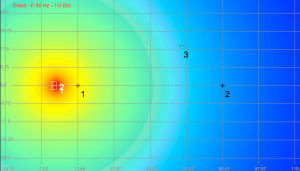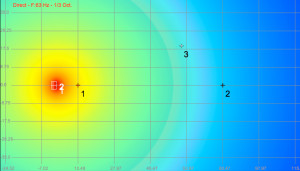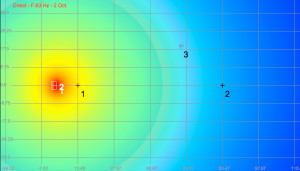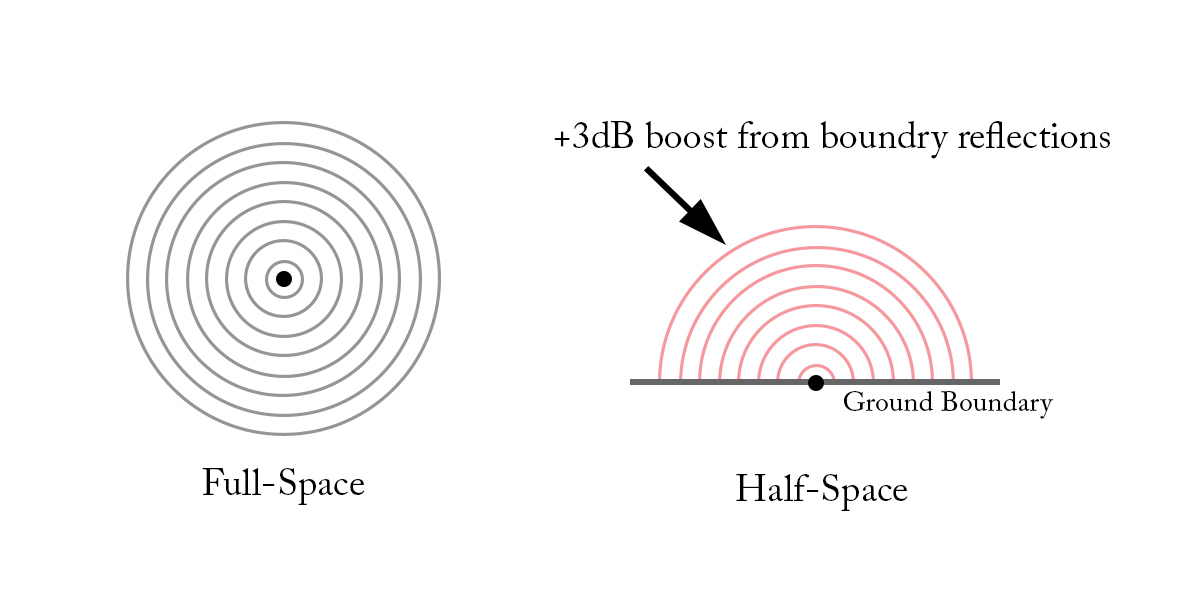Last week I introduced you to Transformation Church and the coverage issues that they were faced with in their middle and upper end of the audio spectrum. Today I am going to talk about their subwoofers. What is amazing is, this is MUCH more common in installations than you may think!

The church has a beautiful stage at the front that spans almost the entire width of the room, and the subwoofers were conveniently placed at either side of the stage. This worked out to be 50 feet apart from each other and 25 feet from the center of the stage. Unlike HF and MF the low end is very omnidirectional when it is being reproduced by most subwoofers. This causes the subwoofers to interact with each other in some very negative ways.
Below are three models of the spaced subwoofers taken at 40Hz, 63Hz and a 2-octave slice of the low end.
As you can see there are spaces like in the middle of the room with a LOT of energy, this is what we call a power alley. Then there are spots with little to no energy which we call power valleys. What is happening here is the subs are summing together in a boosting interaction in the power alleys causing a boost. In the power valleys, there is a subtraction that is happening from the subs being out of phase, this causes a cancellation in these areas. This cancellation in the power valleys cause a 20-30dB drop in SPL in comparison to the power alleys.
Because of the way the church was situated, there was a power alley in the middle section of the church, getting lots of bass. But then the sides were getting little to no low end.
One of my favorite ways to fix this is by placing the subwoofers in the middle of the stage at the front. The only problem with doing this is that most stages need to be built around the subwoofers because of the size. By placing two subwoofers directly side by side to each other, we get back very close to an omnidirectional pattern as seen below. The nice thing about this is that every seat from one side of the room to the other has an even coverage of all of the sub frequencies.
One downside of the center subwoofers is that if you don’t have a stage high enough to fit your subwoofers under, it won’t work aesthetically. The other downfall of the center subwoofers is that you have a drop off in SPL from the low end at the back of the room in comparison to the front. The SPL at the front of the room would have been around 18dB louder than the rear of the room. I wanted to have every seat in the church to have a similar volume and frequency response. Because of this, I decided to fly the subwoofer in the middle of the room above the front of the stage.
Before I go any further, I need to explain that flying a subwoofer WILL drop the max SPL that it will produce in the room. There are two key subwoofer SPL measurements that you will find, Half-Space and Full-Space. Full-space is when a speaker is is located in free space with no boundary close to it. An example of this is a flown subwoofer. With sub frequencies being propagated in an omnidirectional pattern, pressure is measured equal in all directions. When a speaker is located at the edge of a boundary this is known as half-space. An example would be a subwoofer on the ground. The sound that would have been propagated downward is reflected upward resulting in a 3dB increase of pressure above the boundary. You can see an example of this below:
So this means if we normally have one subwoofer on the ground producing 130dB of low end, when we fly the subwoofer in the air it would produce 127dB. To counteract that loss we would need to add one more subwoofer directly adjacent to the first subwoofer to produce the original 127dB of low end.
Now that we know there will be a loss in max SPL when we fly a subwoofer, we can understand that by flying the subwoofer we are able to reduce the amount of SPL drop from the front seat to the back seat. We can see the reduced SPL below, but we can also see that there is only a 7dB loss at the back end of the church as compared to the front row.
With the normal SPL level of the church not needing to be concert level, the loss of max SPL by flying the subwoofers was acceptable for the gain of the more even subwoofer coverage. As you can see looking at the original compared to the flown subwoofers we have a significantly better low-end coverage!
Check out the next blog post where I talk about the final design of the system and how well it performed when everything was set and finished!








